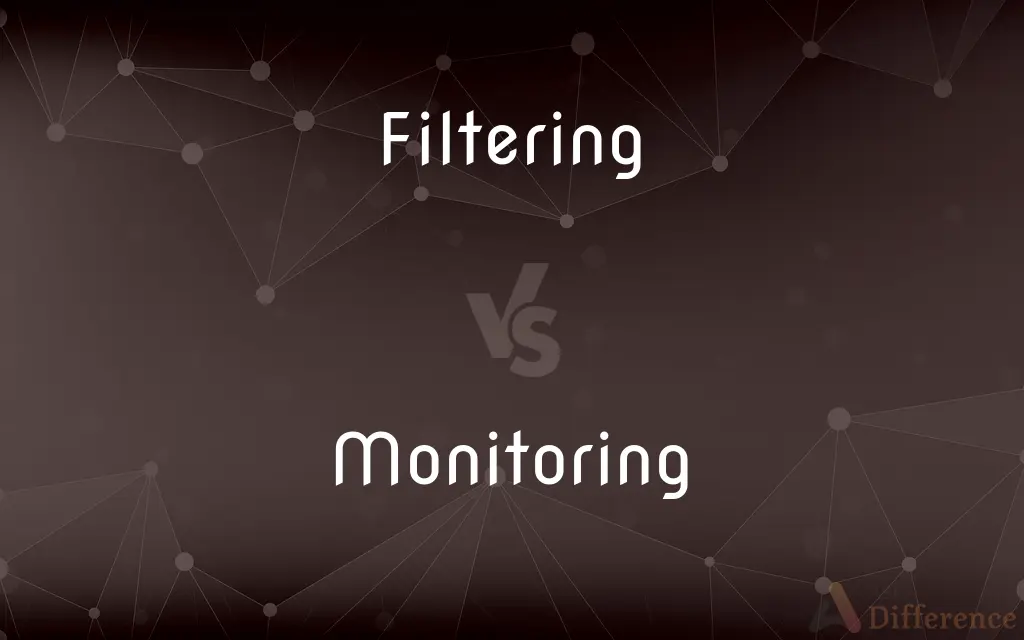Filtering vs. Monitoring — What's the Difference?
By Maham Liaqat & Urooj Arif — Published on April 5, 2024
Filtering involves selectively blocking or allowing content, while monitoring is the continuous observation and recording of activities.

Difference Between Filtering and Monitoring
Table of Contents
ADVERTISEMENT
Key Differences
Filtering is the process of selectively blocking or allowing content based on predefined criteria, often used to restrict access to inappropriate or harmful material. Whereas, monitoring involves the continuous observation and recording of activities or data, aimed at identifying patterns, behaviors, or potential issues.
In the context of digital content, filtering is implemented through software that screens and restricts access to certain websites, emails, or information based on specific rules or keywords. On the other hand, monitoring in this context tracks user activity, usage patterns, and data flow, often for security, compliance, or performance evaluation.
Filtering is proactive, aiming to prevent exposure to unwanted content before it reaches the user. It's akin to setting up a barrier that blocks certain types of information from passing through. Monitoring, however, is reactive, providing insights and data after activities have occurred, like a surveillance system that watches and records events for later review or analysis.
While filtering is often used to protect users, especially minors, from harmful content, and to ensure compliance with organizational policies, monitoring is used to detect unauthorized access, data breaches, performance issues, and to gather data for making informed decisions.
Understanding the difference between filtering and monitoring is crucial for implementing effective digital governance and security strategies. Filtering provides a means of control over the type of content accessed, while monitoring offers visibility into activities and behaviors within a network or system.
ADVERTISEMENT
Comparison Chart
Definition
Selective blocking or allowing of content.
Continuous observation and recording of activities.
Purpose
To restrict access to inappropriate or harmful material.
To identify patterns, behaviors, or potential issues.
Implementation
Through software that screens content based on rules.
Through tracking systems that record data and activities.
Nature
Proactive, preventing unwanted content exposure.
Reactive, providing insights after activities occur.
Use Cases
Protecting users from harmful content, compliance.
Security surveillance, performance evaluation, decision-making.
Compare with Definitions
Filtering
Limiting the transmission of sensitive information to unauthorized recipients.
Data loss prevention systems filter out emails containing confidential data.
Monitoring
Measuring and evaluating the performance of systems and networks.
Network monitoring tools assess bandwidth usage and identify bottlenecks.
Filtering
Restricting access to specific types of content based on criteria such as keywords or ratings.
Parental control software filters out adult content to protect children.
Monitoring
Detecting unauthorized access, data breaches, and other security threats.
Security information and event management (SIEM) systems monitor for signs of cyber attacks.
Filtering
Controlling the types of applications and services that can be accessed on a network.
Corporate firewalls filter out traffic from untrusted sources to protect internal networks.
Monitoring
Analyzing patterns to understand user behavior and preferences.
Website analytics tools monitor visitor interactions to optimize user experience.
Filtering
Screening incoming emails to block spam or phishing attempts.
Email filtering systems automatically move suspected spam to a separate folder.
Monitoring
Observing and recording user actions within a system or network.
Employee monitoring software tracks computer usage during work hours.
Filtering
Preventing access to websites deemed inappropriate or harmful.
School networks use filtering to block access to gaming and social media sites during class hours.
Monitoring
Ensuring that actions and data handling comply with regulations and policies.
Compliance monitoring tools check for adherence to data protection laws.
Filtering
A porous material through which a liquid or gas is passed in order to separate the fluid from suspended particulate matter.
Monitoring
One that admonishes, cautions, or reminds, especially with respect to matters of conduct.
Filtering
A device containing such a material, especially one used to extract impurities from air or water.
Monitoring
A pupil who assists a teacher in routine duties.
Filtering
Any of various electric, electronic, acoustic, or optical devices used to reject signals, vibrations, or radiations of certain frequencies while allowing others to pass.
Monitoring
A usually electronic device used to record, regulate, or control a process or system.
Filtering
A colored glass or other transparent material used to select the wavelengths of light allowed to reach a photosensitive material.
Monitoring
A video display or speaker used in a production studio to check audio or video quality
The sound engineer detected a hiss on the monitor.
Filtering
(Computers) A program or device that blocks email or restricts website access when specific criteria are met.
Monitoring
(Computers)A device that accepts video signals from a computer and displays information on a screen; a video display.
Filtering
(Informal) The ability or tendency to censor oneself, as to avoid causing embarrassment or offense
My roommate has no filter and says whatever he's thinking at the moment.
Monitoring
(Computers)A program that observes, supervises, or controls the activities of other programs.
Filtering
To pass (a liquid or gas) through a filter.
Monitoring
An articulated device holding a rotating nozzle with which a jet of water is regulated, used in mining and firefighting.
Filtering
To remove by passing through a filter
Filter out impurities.
Monitoring
A heavily ironclad warship of the 19th century with a low, flat deck and one or more gun turrets.
Filtering
(Computers) To use a filter to block or restrict access to
A program that filters spam.
Monitoring
A modern warship designed for coastal bombardment.
Filtering
(Informal) To censor (oneself), as to avoid causing embarrassment or offense.
Monitoring
To check the quality or content of (an electronic audio or visual signal) by means of a receiver.
Filtering
To pass through or as if through a filter
Light filtered through the blinds.
Monitoring
To check by means of an electronic receiver for significant content, such as military, political, or illegal activity
Monitor a suspected criminal's phone conversations.
Filtering
To come or go gradually and in small groups
The audience filtered back into the hall.
Monitoring
To keep track of systematically with a view to collecting information
Monitor the bear population of a national park.
Monitored the political views of the people.
Filtering
Present participle of filter
Monitoring
To keep close watch over; supervise
Monitor an examination.
Filtering
The process of passing something through a filter.
Monitoring
Present participle of monitor
Filtering
Something that passes through a filter.
Monitoring
The carrying out of surveillance on, or continuous or regular observation of, an environment or people in order to detect signals, movements or changes of state or quality.
Monitoring
The act of observing something (and sometimes keeping a record of it);
The monitoring of enemy communications plays an important role in war times
Common Curiosities
What role does filtering play in data protection?
Filtering contributes to data protection by preventing the transmission or access of sensitive information to unauthorized parties.
How does monitoring aid in performance evaluation?
Monitoring aids in performance evaluation by tracking and analyzing system or network efficiency, identifying areas for improvement.
How does monitoring contribute to security?
Monitoring helps in security by continuously observing activities, thereby detecting unauthorized access or potential threats in real-time.
What is the primary goal of filtering?
The primary goal of filtering is to block or allow content based on predefined criteria to protect users or comply with policies.
How do organizations use monitoring for compliance?
Organizations use monitoring to ensure that their operations and data handling practices comply with legal and regulatory requirements.
How does network monitoring improve system reliability?
Network monitoring improves system reliability by identifying and addressing performance issues and potential network failures.
How do filtering technologies differ in their approach?
Filtering technologies differ in their approach based on the type of content they target, such as URLs, keywords, or data patterns.
Can filtering alone ensure complete protection against harmful content?
No, filtering alone cannot ensure complete protection, as new or unidentified content might bypass filters, necessitating additional protective measures.
Can filtering and monitoring be used together?
Yes, filtering and monitoring are often used together for comprehensive digital governance, combining preventive control with insightful oversight.
What challenges are associated with content filtering?
Challenges with content filtering include overblocking, underblocking, and maintaining up-to-date criteria for effective screening.
Are there legal limitations to monitoring employee activities?
Yes, there are legal limitations to monitoring employee activities, which vary by jurisdiction and often require transparency and consent.
Is email filtering effective against spam?
Yes, email filtering is an effective tool for blocking spam and phishing attempts by screening emails based on specific criteria.
Can monitoring be invasive to privacy?
Yes, monitoring can be invasive to privacy if not implemented with careful consideration of ethical guidelines and privacy laws.
How do advancements in technology affect monitoring and filtering capabilities?
Advancements in technology enhance monitoring and filtering capabilities by improving accuracy, speed, and the ability to handle complex data sets.
What is the significance of behavioral insights in monitoring?
Behavioral insights gained from monitoring are significant for understanding user preferences, optimizing services, and enhancing user experiences.
Share Your Discovery

Previous Comparison
Silos vs. Siloes
Next Comparison
Timelines vs. Flow ChartsAuthor Spotlight
Written by
Maham LiaqatCo-written by
Urooj ArifUrooj is a skilled content writer at Ask Difference, known for her exceptional ability to simplify complex topics into engaging and informative content. With a passion for research and a flair for clear, concise writing, she consistently delivers articles that resonate with our diverse audience.















































